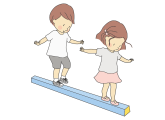Over the course of eight articles Maria Kay highlights the close relationship between music and literacy in the early years, and suggests simple activities to help you develop children’s skills…
In this article, let’s consider the ability to sequence, its importance to literacy development and how musical activities can help with the accomplishment of this ability. Language consists of words in a particular sequence. An appreciation of these patterns helps children to use language correctly. Learning a sequence can help to jog our memory. Songs, rhymes, stories and musical games can help children to comprehend sequences of events and to learn about order. Children need to practise memory and recall in order for it to improve. Piro and Ortiz (Psychology of Music, 37, 2009) found that primary children who had received musical instruction (in this case piano) scored significantly better on verbal sequencing tests than those without this training.
If you think back to your own childhood, you may remember singing ‘The Alphabet Song’ and the ease with which you could then sequence the letters of the alphabet. The song is most often sung to the tune of ‘Twinkle, Twinkle, Little Star’. As the melody is familiar and very rhythmic, the lyrics (letters) become easy to learn – each one supporting the learning of the next.
A, B, C, D, E, F, G
H, I, J, K, L, M, N, O, P
Q, R, S, T, U and V
W, X, Y and Z.
Now I know my ABC
It’s as easy as can be.
Print out the letters of each of your children’s names and encourage them to place them in the correct sequence. Help them until they can do this unaided. This helps children to learn that letters can combine together to make a meaningful word. It is better to teach children lower-case letters initially, as when placed together they form a particular shape for each word, which children will come to recognise. When upper-case letters are used together, all words are the same shape as all the letters are the same height.
The Teddy Bear rhyme helps to promote memory and sequencing skills. Children stand in a circle and act out the words as follows:
Teddy bear, teddy bear, turn around,
Teddy bear, teddy bear, touch the ground.
Teddy bear, teddy bear, take a bow,
Teddy bear, teddy bear, stand up now.
Teddy bear, teddy bear, show your shoe,
Teddy bear, teddy bear, that will do.
Teddy bear, teddy bear, go upstairs,
Teddy bear, teddy bear, say your prayers.
Teddy bear, teddy bear, turn out the light,
Teddy bear, teddy bear, say goodnight.
A favourite musical story of mine that can be used to help children to learn the sequence of a story and the numbers 1–3 is ‘When Goldilocks Went to the House of the Bears’. You’ll find a recording of the song and printable lyrics here. As you sing the song with the children, use the following actions:
● Make an inverted ‘V’ shape with your hands for ‘house’.
● Make circles over your eyes, like glasses with first finger and thumb, for ‘blue eyes’.
● Curve your hands together to form a bowl for ‘bowl’ and decrease the size according to the lyrics.
● Hold one arm up high with outstretched flat hand for ‘chair’ and decrease the size according to the lyrics.
● For ‘bed’, hold hands facing each other as if to clap and widen and decrease size according to lyrics.
● Hold both arms up in the air and make yourself as big as possible for the huge bear; lower hands for the small bear; and crouch down for the tiny bear.
● For counting, hold up the relevant number of fingers, and at the end roar loudly!
This rhyme not only helps children to learn about number, especially if you can supply the sausages (you can get knitted ones online!), but also helps them to respond on cue.
Ten fat sausages sizzling in a pan,
ten fat sausages sizzling in a pan,
and if one went POP and the other went BANG,
there’d be eight fat sausages sizzling in a pan.
Pass a drum and beater round and let the children take it in turns to hit the drum on POP and BANG. Count down in twos. If there are more than five children, increase the number of sausages accordingly. If you want to count down single numbers sing ‘If one went POP and then it went BANG’.
Next up, read Maria’s article on how music can be used to help children to learn about the world around them.
Maria is the author of Sound Before Symbol: Developing Literacy through Music and Alphabet Book + More: A Sounds and Symbols ‘literacy through music’ book. Her Sounds and Symbols Literacy through Music Resource Pack (£489) is available now. It is a comprehensive, research-based and informative resource, full of engaging activities and is perfect for building foundational literacy skills in the early years (0–8 years). Email .(JavaScript must be enabled to view this email address) or visit bryantandkaypublishing.co.uk

Early Years development – How to support children
Editors picks
